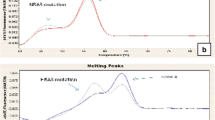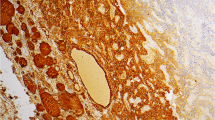Abstract
Mutational changes in the p53 tumor suppressor gene are the most frequent genetic alterations in human malignant tumors. Studies have shown a correlation of p53 expression in breast cancer with tumor prognosis. In contrast to mutational activation of ras and GSP in thyroid tumors, little is known about the role of p53 in thyroid tumor development. Therefore thyroid tumors and thyroid tumor cell lines were studied for the presence of p53 mutations. Snap-frozen tissues from 57 differentiated thyroid carcinomas (DTCs) and 5 goiters were studied by immunohistochemical methods. A panel of six antibodies (pAb 240, 421, 1620, 1801, DO7, and CM1) was employed by using the ABC technique. Five cell lines from DTCs (FTC133, 236, 238, PTC337, MTC164) were examined by the same technique. Additionally, genomic DNA from the cells was amplified by the polymerase chain reaction (PCR) and the PCR product studied for p53 mutations (R273H) by mutation-specific oligonucleotide hybridization (MOH) and temperature gradient gel electrophoresis (TGGE) for the p53 exon 8. None of the benign thyroid tumors and 7 of 57 (12%) DTCs strongly express p53 with a heterogeneous distribution in the tumor tissue. All seven patients have metastatic disease or dedifferentiated tumors G3 (three of seven). CM1 was positive in two cell lines (FTC-133, PTC-337), questionable in FTC-238, and negative in FTC-236 and MTC-164. All three follicular cell lines, however, and the original tumor tissue showed the same p53 mutation (R273H) in MOH analysis and TGGE. P53 mutations are rare in thyroid tumors, but the presence of p53 mutations indicates a poor prognosis. TGGE seems to be a sensitive method for detecting p53 mutations (1% sensitivity) and might play a role in tumor screening in the future.
Résumé
Les mutations du gêne de la suppression tumorale p 53 sont parmi les plus fréquentes des altérations génétiques en matière de tumeur maligne de l'homme. Des études récentes ont démontré une corrélation étroite entre l'expression p 53 du cancer du sein et le pronostic de ces tumeurs. Au contraire de la mutation du ras et de la GSP dans les tumeurs thyroïdiennes, on connaît peu de choses sur le rôle du p 53 dans le développement des tumeurs de la thyroïde. Nous avons donc étudié les tumeurs de la thyroïde et les clones cellulaires de ces tumeurs à la recherche de mutations p53. Les coupes provenant de 57 cancers de la thyroïde et cínq goitres ont été examinés en immunohistochimie. Six anticorps différents ont été employés pour l'étude ABC (pAb 240, 421, 1620, 1801, D07 et CM1). Cinq lignées cellulaires des cancers thyroïdiens (FTC 133, 236, 238, PTC337 et MTC164) ont été examinées par la même technique. L'ADN génomique des cellules a été amplifié par le PCR qui a été ensuite étudié pour la présence de mutation p 53 (R273H) par une hybridation oligonucléotide spécifique et une électrophorèse de gradient sur gel thermique pour l'exon 8 du p 53. Aucune des tumeurs bénignes et 7 des 57 tumeurs malignes (12%) avaient une expression soutenue de P 53 avec une distribution hétérogène dans le tissu tumoral. Tous les patients avec cancer (7/7) avaient des métastases ou des tumeurs dédifférenciées (3/7). La CM1 était positive dans deux des lignées cellulaires (FTC-133 et PTC-337), douteuses dans une autre (FTC-238) et enfin négative dans deux autres (FTC-236 et MTC-164). Toutes les lignées cellulaires folliculaires et la tumeur originale présentaient la même mutation (R273H) en analyse MOH et TGGE. Les mutation P53 sont rares dans le cancer de la thyroïde et la présence de la mutation p 53 est associée avec un mauvais pronostic. La TGGE semble être une méthode sensible pour la détection de la mutation p 53 ?(sensibilité de 1%)? et peut jouer un rôle à l'avenir.
Resumen
Las alteraciones mutacionales en el gen supresor de tumores p53 son las anomalías genéticas más frecuentes en los tumores malignos humanos. Estudios recientes demuestran una correlacíon de la expresión del gen p53 en el cáncer mamario con el pronóstico tumoral. En contraste con la activación mutacional de ras y de GSP en tumores tiroideos, es poco lo que se conoce sobre el papel del gen p53 en el desarrollo de los tumores tiroideos.
Por ello procedimos a estudiar tumores tiroideos y líneas celulares de tumores tiroideos para determinar la presencia de mutaciones p53. Se estudiaron tejidos congelados de 57 diferentes carcinomas diferenciados de la glándula tiroides (CDT) y de 5 bocios mediante métodos inmunohistológicos. Un panel de 6 anticuerpos diferentes (pAb 240, 421, 1620, 1801, D07 y CM1) fue empleado utilizando la técnica ABC. Cinco líneas celulares de CDTs (FTC 133, 236, 238, PTC337, MTC164) fueron examinados mediante la misma técnica. Adicionalmente, el ADN genómico de las células fue amplificado por la reacción en cadena de la polimerasasa (PCR) y el producto de la PCR estudiado para mutaciones p53 (R273H) mediante la hibridación específica de oligonucleótidos (MOH) y electroforesis de gel por gradiente de temperatura (TGEE) para el p53-exon 8. ninguno de los tumores tiroideos benignos y 7 de 57 (12%) CTDs exhibieron expresión fuerte de p53 con una heterogénea distribución en el tejido tumoral. Todos estos 7 pacientes tienen enfermedad metastásica (7/7) o tumores G3 desdiferenciados (3/7). La CM1 fue positiva en 2 líneas celulares (FTC-133, PTC-337), cuestionable en FTC-238 y negativa en FTC-236 y MTC-164. Sin embargo, todas las líneas foliculares y el tejido del tumor original mostraron la misma mutación p53 (R273H) en el análisis MOH y TGGE.
Las mutaciones p53 son raras en los tumores tiroideos, pero la presencia de mutaciones p53 es indicativa de un pronóstico pobre. E1 TGEE parece ser un método sensitivo para la detección de mutaciones p53 (sensibilidad 1%) y podría jugar un papel significativo en cuanto al tamizaje tumoral en el futuro.
Similar content being viewed by others
References
Chen, T.M., Defendi, V.: Functional interaction of p53 with HPV18E6, c.myc and H-ras in 3T3 cells. Oncogene 7:1541, 1992
Finlay, C.A., Hinds, P.W., Levine, A.J.: The p53 protooncogene can act as a suppressor of transformation. Cell 57:1083, 1989
Wolf D., Harris, N., Rotter, V.: Reconstitution of p53 expression in nonproducer Ab-MuLV-transformed cell line by transfection of a functional p53 gene. Cell 38:119, 1984
Eliyahu, D., Raz, A., Gruss, P., Givol, D., Oren, M.: Participation of p53 cellular tumor antigen in transformation of normal embryonic cells. Nature 312:646, 1984
Parada, L.F., Lang, H., Weinberg, R.A., Wolf, D., Rotter, V.: Cooperation between gene encoding p53 tumor antigen and ras in cellular transformation. Nature 312:649, 1984
Jenkins, J.R., Rudge, K., Currie, G.A.: Cellular immortalization by a cDNA clone encoding the transformation-associated phosphoprotein p53. Nature 312:651, 1984
Hinds, P.W., Finlay, C.A., Quartin, R.W., et al.: Mutant p53 DNA clones from human colon carcinomas cooperate with ras in transforming primary rat cells: a comparison of the “hot spot” mutant phenotypes. Cell Growth Differ. 1:571, 1990
Goretzki, P.E., Lyons, J., Stacy-Philips, S., et al.: Mutational activation of ras and GSP oncogenes in differentiated thyroid cancer and their biological implications. World J. Surg. 16:576, 1992
Bartek, J., Iggo, R., Gannon, J., Lane, D.P.: Genetic and immunohistochemical analysis of mutant p53 in breast cancer cell lines. Oncogene 5:893, 1990
Davidoff A.M., Humphrey, P.A., Iglehart, J.D., Marks, J.R.: Genetic basis for p53 overexpression in human breast cancer. Proc. Natl. Acad. Sci. U.S.A. 88:5006, 1991
Vogelstein B., Kinzler, K.W.: P53 function and dysfunction. Cell 70:523, 1992
Montenarh, M.: Biochemical properties of the growth suppressor/oncoprotein p53. Oncogene 7:1673, 1991
Kastan, M.B., Onyekwere, O., Sidransky, D., Vogelstein, B., Craig, R.W.: Participation of p53 protein in the cellular response to DNA damage. Cancer Res. 51:6304, 1991
Walker, R.A., Dearing, S.J., Lane, D.P., Varley, J.M.: Expression of p53 protein in infiltrating and in-situ breast carcinomas. J. Pathol. 165:203, 1991
Cattoretti G., Rilke, F., Andreola, S., D'Amato, L., Delia, D.: P53 expression in breast cancer. Int. J. Cancer 41:178, 1988
Isola, J., Visakorpi, T., Holli, K., Kallioniemi, O.P.: Association of overexpression of tumor suppressor protein p53 with rapid cell proliferation and poor prognosis in node-negative breast cancer patients. J. Natl. Cancer Inst. 84:1109, 1990
Martin, H.M., Filipe, M.I., Morris, R.W., Lane, D.P., Silvestre, F.: P53 expression and prognosis in gastric carcinoma. Int. J. Cancer 50:859, 1992
Rosenbaum, V., Riesner, D.: Temperature gradient gel electrophoresis. Biophys. Chem. 26:235, 1987
Riesner, D., Steger, G., Zimmat, R., et al.: TGGE of nucleic acids: analysis of conformational transitions, sequence variations, and protein-nucleic acid interactions. Electrophoresis 10:377, 1989
Poland, D.: Cooperative Equilibria in Physical Biochemistry. Oxford, Oxford University Press, 1978
Myers R.M., Fischer, S.G., Maniatis, T., Lerman, L.S.: Modification of the melting properties of duplex DNA by attachment of a GC-rich DNA sequence as determined by denaturing gradient gel electrophoresis. Nucleic Acids Res. 13:3111, 1985
Myers, R.M., Fischer, S.G., Lerman, L.S., Maniatis, T.: Nearly all single base substitutions in DNA fragments joined to a GC-clamp can be detected by denaturing gradient gel electrophoresis. Nucleic Acids Res. 13:3131, 1985
Nigro, J.M., Baker, S.J., Preisinger, A.C., et al.: Mutations in the p53 gene occur in diverse human tumor types. Nature 342:705, 1989
Matozaki, T., Sakamoto, C., Suzuki, T., et al.: P53 gene mutations in human gastric cancer: wild-type p53 but not mutant p53 suppresses growth of human gastric cancer cells. Cancer Res. 52:4335, 1992
Hollstein, M., Sidransky, D., Vogelstein, B., Harris, C.C.: P53 mutations in human cancers. Science 253:49, 1991
Sidransky, D., von Eschenbach, A., Tsai, Y.C., et al.: Identification of p53 gene mutations in bladder cancers and urine samples. Science 252:706, 1991
Scheffner, M., Münger, K., Byrne, J.C., Howley, P.M.: The state of the p53 and retinoblastoma genes in human cervical carcinoma cell lines. Proc. Natl. Acad. Sci. U.S.A. 88:5523, 1991
Eccles, D.M., Brett, L., Lessells, A., et al.: Overexpression of the p53 protein and allele loss at 17p13 in ovarian carcinoma. Br. J. Cancer 65:40, 1992
Iggo, R., Gatter, K., Bartek, J., Lane, D.P. Harris, A.L.: Increased expression of mutant forms of p53 oncogene in primary lung cancer. Lancet 335:675, 1990
Baker, S.J., Fearon, E.R., Nigro, J.M., et al.: Chromosome 17 deletion and p53 gene mutations in colorectal carcinomas. Science 244:217, 1989
Lyons, J., Landis, C.A., Harsh, G., et al.: Two G-protein mutations in human endocrine tumors. Science 249:655, 1990
Yewdell, J.W., Gannon, J.V., Lane, D.P.: Monoclonal antibody analysis of p53 expression in normal and transformed cells. J. Virol. 59:444, 1986
Levine, A.J., Momand, J., Finlay, C.A.: The p53 tumour suppressor gene. Nature 351:453, 1991
Bartek, J., Bartkova, J., Vojtesek, B., et al.: Patterns of expression of the p53 tumor suppressor in human breast tissues and tumours in situ and in vitro. Int. J. Cancer 46:839, 1990
Sidransky, D., Mikkelsen, T., Schwechheimer, K., Rosenblum, M.L., Cavanee, W., Vogelstein, B.: Clonal expansion of p53 mutant cells is associated with brain tumor progression. Nature 335:46, 1992
Kuerbitz, S.J., Plunkett, B.S., Walsh, W.V., Kastan, M.B.: Wildtype p53 is a cell cycle checkpoint determinant following irradiation. Proc. Natl. Acad. Sci. U.S.A. 89:7491, 1992
Author information
Authors and Affiliations
Rights and permissions
About this article
Cite this article
Simon, D., Goretzki, P.E., Goreley, V. et al. Significance of P53 in human thyroid tumors. World J. Surg. 18, 535–540 (1994). https://doi.org/10.1007/BF00353758
Issue Date:
DOI: https://doi.org/10.1007/BF00353758




